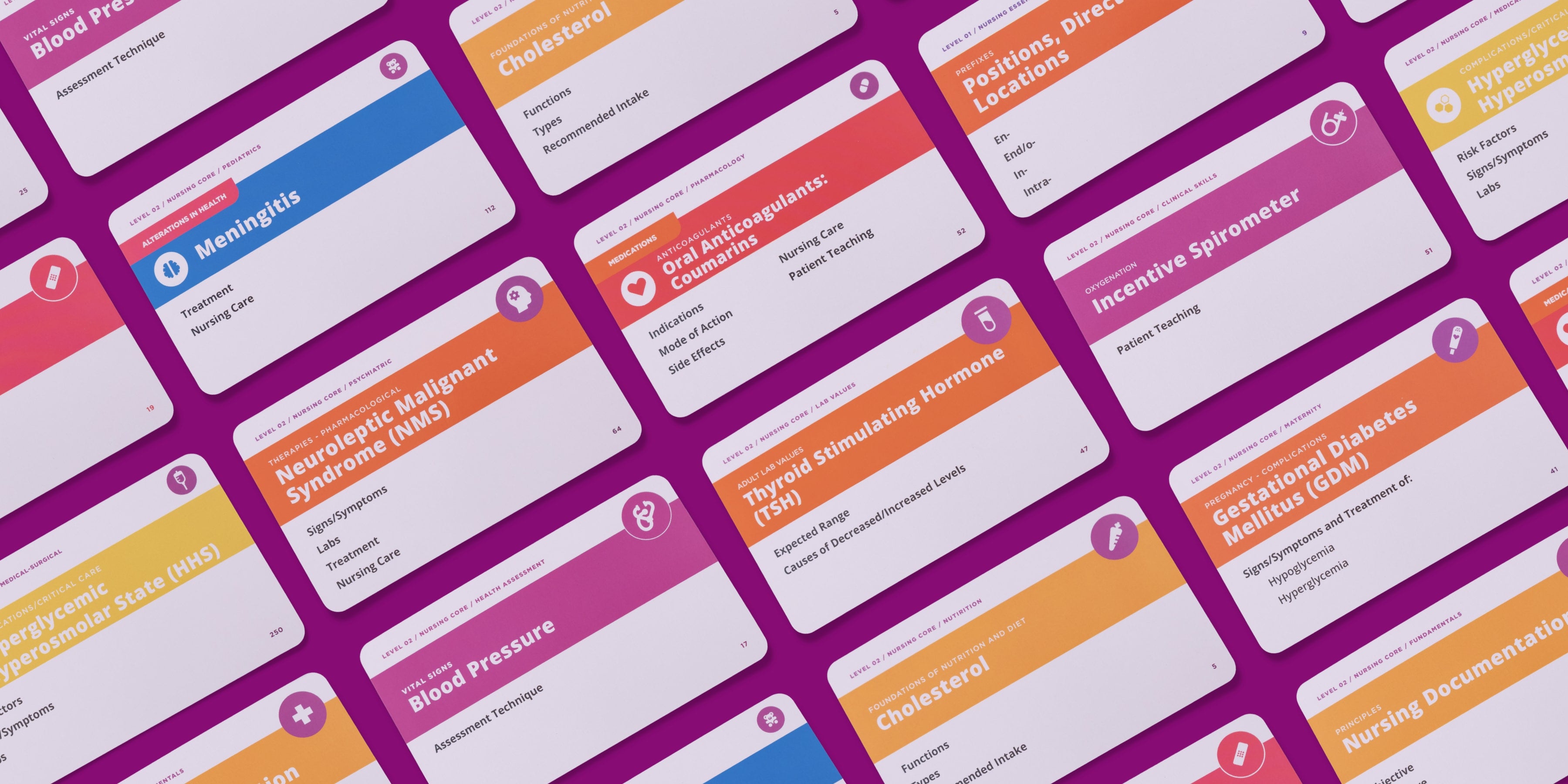
Latest in Nursing Content
Arterial Blood Gas (ABG) Interpretation
View all-
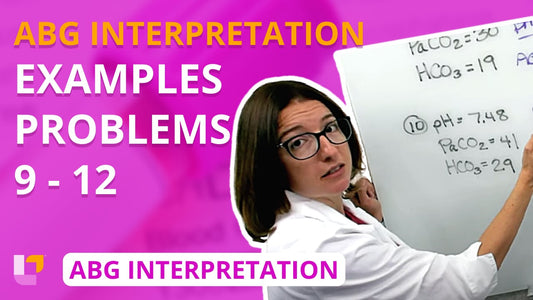
ABG Interpretation, part 10: Example problems 9-12
In this video, Cathy covers ABG interpretation practice problems 9-12. You can download the practice questions and answer key and follow along as she explains how to work through the...
4 commentsABG Interpretation, part 10: Example problems 9-12
In this video, Cathy covers ABG interpretation practice problems 9-12. You can download the practice questions and answer key and follow along as she explains how to work through the...
4 comments -
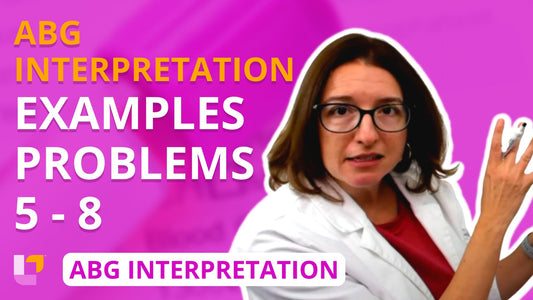
ABG Interpretation, part 9: Example problems 5-8
In this video, Cathy covers ABG interpretation practice problems 5-8. You can download the practice questions and answer key and follow along as she explains how to work through the...
1 commentABG Interpretation, part 9: Example problems 5-8
In this video, Cathy covers ABG interpretation practice problems 5-8. You can download the practice questions and answer key and follow along as she explains how to work through the...
1 comment -
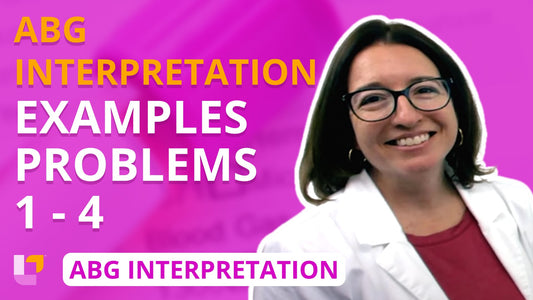
ABG Interpretation, part 8: Example problems 1-4
In this video, Cathy covers ABG interpretation practice problems 1-3. You can download the practice questions and answer key and follow along as she explains how to work through the...
4 commentsABG Interpretation, part 8: Example problems 1-4
In this video, Cathy covers ABG interpretation practice problems 1-3. You can download the practice questions and answer key and follow along as she explains how to work through the...
4 comments -

ABG Interpretation, part 7: Metabolic Alkalosis
ABG results for: Uncompensated Metabolic Alkalosis, Partially compensated Metabolic Alkalosis, and Fully compensated Metabolic Alkalosis. Plus, learn the causes, symptoms, and treatment of Metabolic Alkalosis.
ABG Interpretation, part 7: Metabolic Alkalosis
ABG results for: Uncompensated Metabolic Alkalosis, Partially compensated Metabolic Alkalosis, and Fully compensated Metabolic Alkalosis. Plus, learn the causes, symptoms, and treatment of Metabolic Alkalosis.
Clinical Nursing Skills
View all-
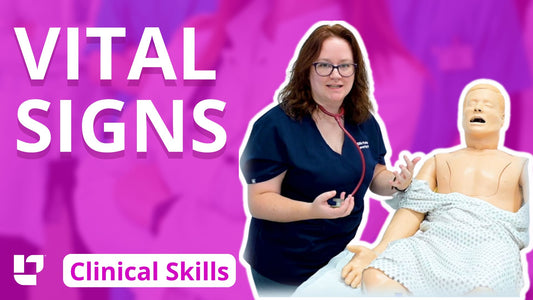
Clinical Skills - Vital Signs: Temperature, Pulse, Respirations & Blood Pressure
A demonstration on how to obtain vital signs including temperature (oral, axillary, temporal, tympanic and rectal), pulse (palpating and auscultating), respirations, and blood pressure.
2 commentsClinical Skills - Vital Signs: Temperature, Pulse, Respirations & Blood Pressure
A demonstration on how to obtain vital signs including temperature (oral, axillary, temporal, tympanic and rectal), pulse (palpating and auscultating), respirations, and blood pressure.
2 comments -
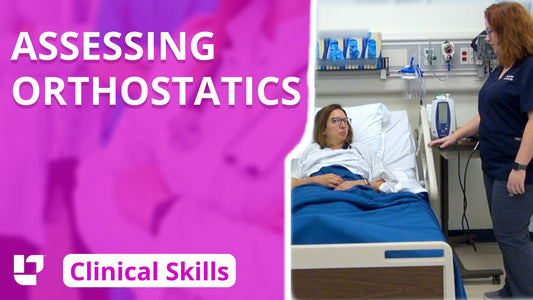
Clinical Skills - Assessing Orthostatics
A demonstration on how to assess a patient's orthostatic blood pressure, with the assistance of a special guest.
Clinical Skills - Assessing Orthostatics
A demonstration on how to assess a patient's orthostatic blood pressure, with the assistance of a special guest.
-

Clinical Skills - IV Piggyback (Secondary)
A demonstration on how to set up an intravenous piggyback medication (secondary).
Clinical Skills - IV Piggyback (Secondary)
A demonstration on how to set up an intravenous piggyback medication (secondary).
-

Clinical Skills - IV Push Medication
A demonstration on how to administer intravenous medication (usually called IV push) using a saline loc without an attached line and though a port with a continuous IV solution running.
Clinical Skills - IV Push Medication
A demonstration on how to administer intravenous medication (usually called IV push) using a saline loc without an attached line and though a port with a continuous IV solution running.
Dosage Calculation
View all-
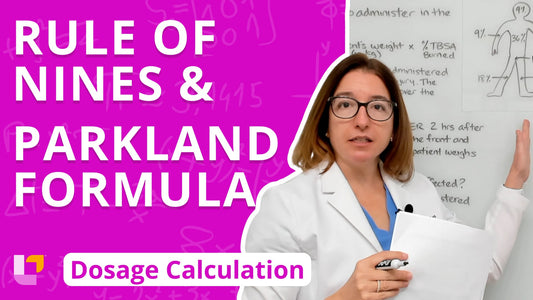
Dosage Calc, part 35: Rule of Nines and Parkland Formula
How the Rule of Nines and the Parkland Formula are used to guide fluid resuscitation with severe burns. An example problem that uses both the Rule of Nines and the...
Dosage Calc, part 35: Rule of Nines and Parkland Formula
How the Rule of Nines and the Parkland Formula are used to guide fluid resuscitation with severe burns. An example problem that uses both the Rule of Nines and the...
-
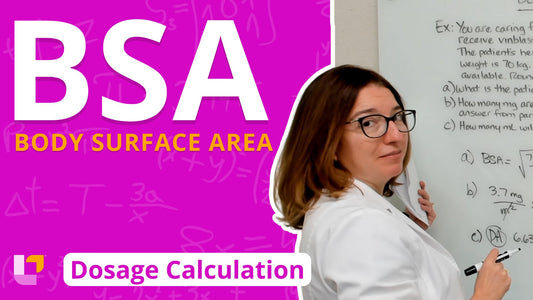
Dosage Calc, part 34: Body Surface Area
The formula used to calculate a patient’s body surface area (BSA) and a dosage calculation problem based on a patient’s BSA, using multiple methods, including dimensional analysis, ratio & proportion,...
Dosage Calc, part 34: Body Surface Area
The formula used to calculate a patient’s body surface area (BSA) and a dosage calculation problem based on a patient’s BSA, using multiple methods, including dimensional analysis, ratio & proportion,...
-
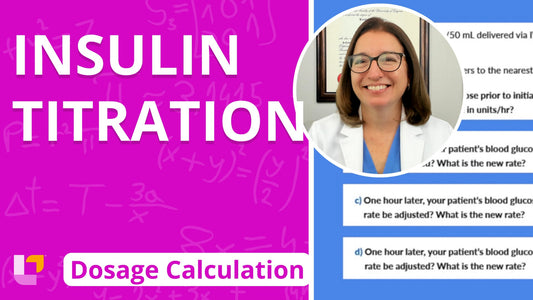
Dosage Calc, part 33: Insulin Titration
A dosage calculation problem involving insulin titration and the use of an insulin drip protocol.
1 commentDosage Calc, part 33: Insulin Titration
A dosage calculation problem involving insulin titration and the use of an insulin drip protocol.
1 comment -
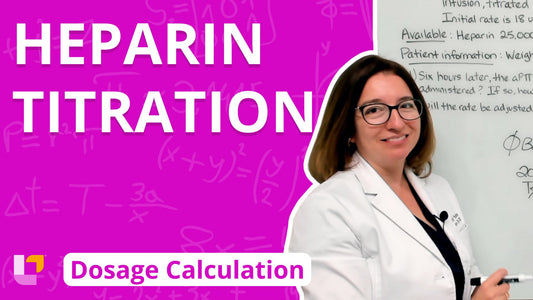
Dosage Calc, part 32: Heparin Titration
A dosage calculation problem involving heparin titration, using multiple methods, including dimensional analysis, ratio & proportion, and the formula method.
Dosage Calc, part 32: Heparin Titration
A dosage calculation problem involving heparin titration, using multiple methods, including dimensional analysis, ratio & proportion, and the formula method.
EKG Interpretation
View all-

EKG Interpretation, part 1: Introduction
In this introduction video, Cathy goes over the key information that will be covered in her EKG interpretation video series, which is intended to help nurses, nursing students, and other...
3 commentsEKG Interpretation, part 1: Introduction
In this introduction video, Cathy goes over the key information that will be covered in her EKG interpretation video series, which is intended to help nurses, nursing students, and other...
3 comments -

EKG Interpretation, part 2: Placement of EKG leads, Heart Conduction System and EKG Basics
Learn where to place the 10 electrodes when performing a 12 lead EKG, the steps in the Heart Conduction System, and how those steps are reflected on an EKG waveform. Plus EKG...
3 commentsEKG Interpretation, part 2: Placement of EKG leads, Heart Conduction System and EKG Basics
Learn where to place the 10 electrodes when performing a 12 lead EKG, the steps in the Heart Conduction System, and how those steps are reflected on an EKG waveform. Plus EKG...
3 comments -
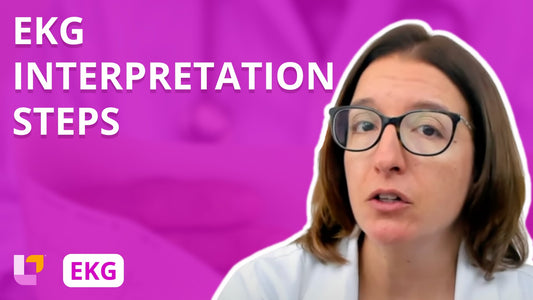
EKG Interpretation, part 3: Analysis of Heart Rhythm, Heart Rate, P wave, PR interval and QRS complex
In this article, we cover the key steps in analyzing an EKG strip: determining the heart rhythm (regular vs. irregular), determining the heart rate using small box method vs. big...
5 commentsEKG Interpretation, part 3: Analysis of Heart Rhythm, Heart Rate, P wave, PR interval and QRS complex
In this article, we cover the key steps in analyzing an EKG strip: determining the heart rhythm (regular vs. irregular), determining the heart rate using small box method vs. big...
5 comments -
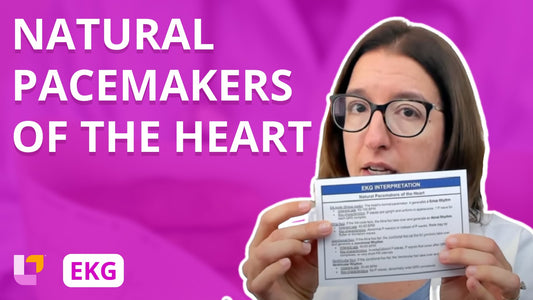
EKG Interpretation, part 4: Natural Pacemakers of the Heart - Key Differentiating Factors
Learn about the different natural pacemakers in the heart: the SA node, the atria foci, the junctional foci, and the ventricular foci. We describe the inherent rate and key characteristics of each pacemaker,...
2 commentsEKG Interpretation, part 4: Natural Pacemakers of the Heart - Key Differentiating Factors
Learn about the different natural pacemakers in the heart: the SA node, the atria foci, the junctional foci, and the ventricular foci. We describe the inherent rate and key characteristics of each pacemaker,...
2 comments
Fundamentals of Nursing
View all-

Fundamentals - Community Health, part 9: Disasters and Triage
Different actions that should occur before, during, and after disasters. These include mitigation, preparedness, response, and recovery. the classification system used to triage during mass casualty events.
Fundamentals - Community Health, part 9: Disasters and Triage
Different actions that should occur before, during, and after disasters. These include mitigation, preparedness, response, and recovery. the classification system used to triage during mass casualty events.
-

Fundamentals - Community Health, part 8: Epidemiology
Epidemiology including the epidemiologic triangle. This triangle consists of the agent, host, and environment. Ellis then discusses other important terms in epidemiology like incidence, prevalence, attack rate, endemic, epidemic, and...
2 commentsFundamentals - Community Health, part 8: Epidemiology
Epidemiology including the epidemiologic triangle. This triangle consists of the agent, host, and environment. Ellis then discusses other important terms in epidemiology like incidence, prevalence, attack rate, endemic, epidemic, and...
2 comments -
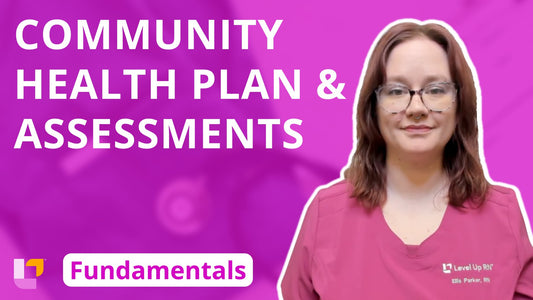
Fundamentals - Community Health, part 7: Community Health Plan and Assessments
The nursing process steps as they relate to developing a community health plan, including specific data collection methods used in the assessment of a community like informal interviews, direct observation,...
Fundamentals - Community Health, part 7: Community Health Plan and Assessments
The nursing process steps as they relate to developing a community health plan, including specific data collection methods used in the assessment of a community like informal interviews, direct observation,...
-
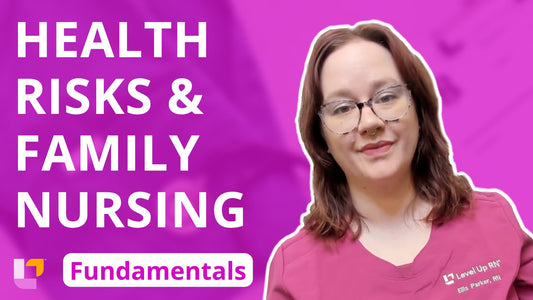
Fundamentals - Community Health, part 6: Health Risks and Family Nursing
Health risks across the lifespan by discussing health risks specific to infants, children, adolescents, and adults, including any related family or patient teaching. Family nursing is also discussed by reviewing...
Fundamentals - Community Health, part 6: Health Risks and Family Nursing
Health risks across the lifespan by discussing health risks specific to infants, children, adolescents, and adults, including any related family or patient teaching. Family nursing is also discussed by reviewing...
Health Assessment
View all-

Health Assessment, part 24: Cranial Nerve III - Oculomotor
Meris reviews the number, name, type, function, and assessment (e.g., corneal light reflex, cover test, and six cardinal positions of gaze) of cranial nerve III (oculomotor).
Health Assessment, part 24: Cranial Nerve III - Oculomotor
Meris reviews the number, name, type, function, and assessment (e.g., corneal light reflex, cover test, and six cardinal positions of gaze) of cranial nerve III (oculomotor).
-

Health Assessment, part 23: Cranial Nerve II - Optic
Meris reviews the number, name, type, function, and assessment (e.g., Snellen test, Jaeger test, Ishihara color test, and confrontation test) of cranial nerve II (optic).
Health Assessment, part 23: Cranial Nerve II - Optic
Meris reviews the number, name, type, function, and assessment (e.g., Snellen test, Jaeger test, Ishihara color test, and confrontation test) of cranial nerve II (optic).
-

Health Assessment, part 22: Cranial Nerve I - Olfactory
Meris reviews how to assess the number, name, type, and function of cranial nerve I (olfactory).
Health Assessment, part 22: Cranial Nerve I - Olfactory
Meris reviews how to assess the number, name, type, and function of cranial nerve I (olfactory).
-

Health Assessment, part 21: Cranial Nerve Overview
The number, name, type, and function(s) of all 12 cranial nerves, and two helpful mnemonics to remember their names and types.
Health Assessment, part 21: Cranial Nerve Overview
The number, name, type, and function(s) of all 12 cranial nerves, and two helpful mnemonics to remember their names and types.
Maternity Nursing
View all-

Maternity - Postpartum, part 5: Postpartum Hemorrhage, Endometritis, Mastitis, Mental Health Concerns
The postpartum complications of postpartum hemorrhage, endometritis, mastitis, and potential mental health concerns.
3 commentsMaternity - Postpartum, part 5: Postpartum Hemorrhage, Endometritis, Mastitis, Mental Health Concerns
The postpartum complications of postpartum hemorrhage, endometritis, mastitis, and potential mental health concerns.
3 comments -
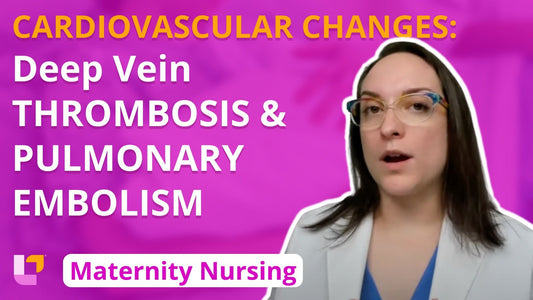
Maternity - Postpartum, part 4: Changes, Deep Vein Thrombosis, Pulmonary Embolism
Cardiovascular changes of the postpartum patient. In addition, the potential postpartum complications of deep vein thrombosis (DVT), and pulmonary embolism (PE).
Maternity - Postpartum, part 4: Changes, Deep Vein Thrombosis, Pulmonary Embolism
Cardiovascular changes of the postpartum patient. In addition, the potential postpartum complications of deep vein thrombosis (DVT), and pulmonary embolism (PE).
-
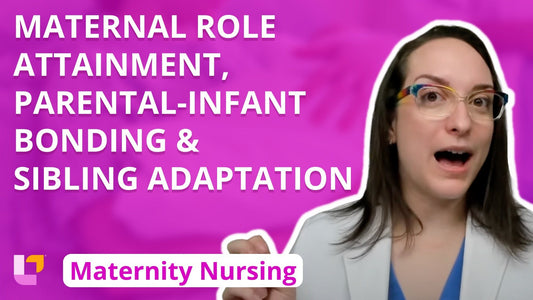
Maternity - Postpartum, part 3: Maternal Role Attainment, Parental-Infant Bonding, Sibling Adaptation
The three phases of maternal role attainment, signs of optimal and impaired parental-infant bonding, parental teaching related to sibling adaptation, and patient teaching on sexual intercourse in the postpartum period.
Maternity - Postpartum, part 3: Maternal Role Attainment, Parental-Infant Bonding, Sibling Adaptation
The three phases of maternal role attainment, signs of optimal and impaired parental-infant bonding, parental teaching related to sibling adaptation, and patient teaching on sexual intercourse in the postpartum period.
-
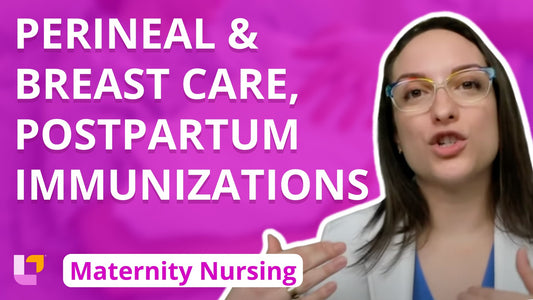
Maternity - Postpartum, part 2: Perineal and Breast Care, Postpartum Immunizations
Patient teaching of postpartum perineal and breast care, along with postpartum immunizations which may be provided to the mother prior to discharge.
Maternity - Postpartum, part 2: Perineal and Breast Care, Postpartum Immunizations
Patient teaching of postpartum perineal and breast care, along with postpartum immunizations which may be provided to the mother prior to discharge.
Medical-Surgical Nursing
View all-
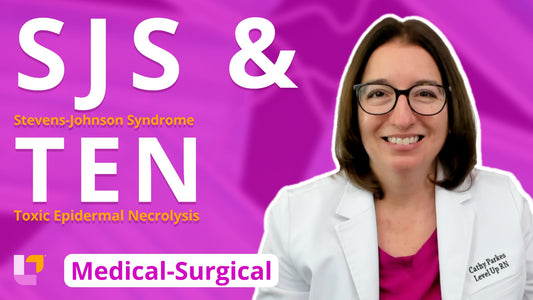
Med-Surg - Integumentary System, part 11: SJS and TEN
Stevens-Johnson Syndrome (SJS) and Toxic Epidermal Necrolysis (TEN), including pathophysiology, signs/symptoms, diagnosis, treatment, and nursing care for these life-threatening skin reactions.
1 commentMed-Surg - Integumentary System, part 11: SJS and TEN
Stevens-Johnson Syndrome (SJS) and Toxic Epidermal Necrolysis (TEN), including pathophysiology, signs/symptoms, diagnosis, treatment, and nursing care for these life-threatening skin reactions.
1 comment -
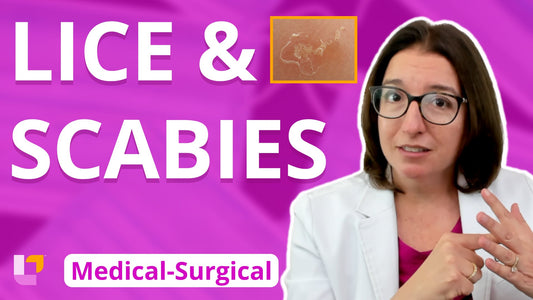
Med-Surg - Integumentary System, part 10: Lice & Scabies
Parasitic infestations, including pediculosis (i.e., lice) and scabies. Risk factors, signs/symptoms, treatment and patient teaching for lice and scabies.
Med-Surg - Integumentary System, part 10: Lice & Scabies
Parasitic infestations, including pediculosis (i.e., lice) and scabies. Risk factors, signs/symptoms, treatment and patient teaching for lice and scabies.
-
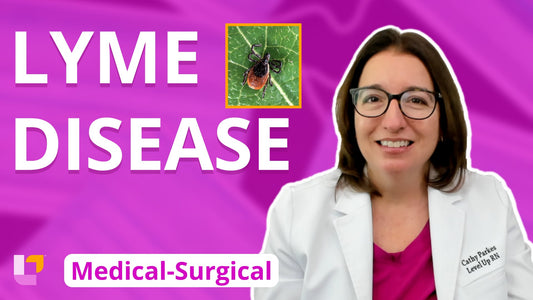
Med-Surg - Integumentary System, part 9: Lyme Disease
Lyme disease—the prevention, stages of lyme disease, symptoms of lyme disease, diagnosis and treatment.
1 commentMed-Surg - Integumentary System, part 9: Lyme Disease
Lyme disease—the prevention, stages of lyme disease, symptoms of lyme disease, diagnosis and treatment.
1 comment -
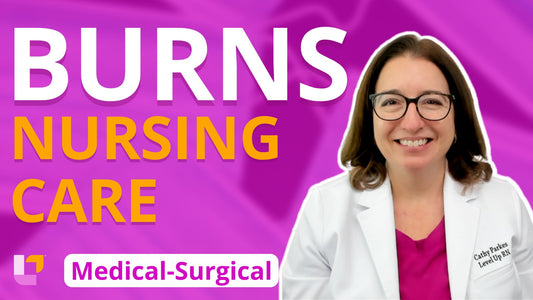
Med-Surg - Integumentary System, part 8: Nursing Care of Burns
Nursing care of patients with burns, including the phases of burn care and priorities during each phase, calculating the percentage of the patient's body affect by a burn using the...
1 commentMed-Surg - Integumentary System, part 8: Nursing Care of Burns
Nursing care of patients with burns, including the phases of burn care and priorities during each phase, calculating the percentage of the patient's body affect by a burn using the...
1 comment
Nursing Pharmacology
View all-

Pharmacology, part 9: Anticholinergic Effects, Bleeding & Infection Precautions
Anticholinergic side effects, increased risk of bleeding, and increased risk of infection. Key meds and classes with anticholinergic side effects. Anticholinergic signs and symptoms, nursing care and patient teaching. Key meds that...
1 commentPharmacology, part 9: Anticholinergic Effects, Bleeding & Infection Precautions
Anticholinergic side effects, increased risk of bleeding, and increased risk of infection. Key meds and classes with anticholinergic side effects. Anticholinergic signs and symptoms, nursing care and patient teaching. Key meds that...
1 comment -

Pharmacology, part 8: Antidotes & Antibiotic Teaching
The antidotes for key medications and important nursing care and patient teaching for patients taking antibiotics.
1 commentPharmacology, part 8: Antidotes & Antibiotic Teaching
The antidotes for key medications and important nursing care and patient teaching for patients taking antibiotics.
1 comment -
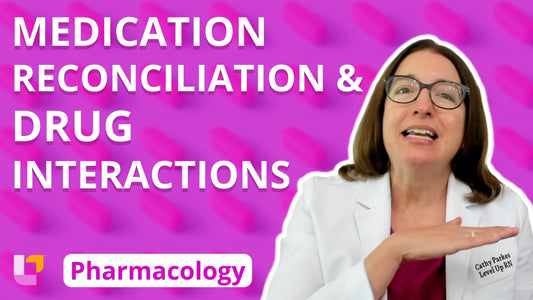
Pharmacology, part 7: Medication Reconciliation, Herb-Drug & Food-Drug Interactions
An overview of medication reconciliation, key herb-drug interactions and food-drug interactions.
Pharmacology, part 7: Medication Reconciliation, Herb-Drug & Food-Drug Interactions
An overview of medication reconciliation, key herb-drug interactions and food-drug interactions.
-
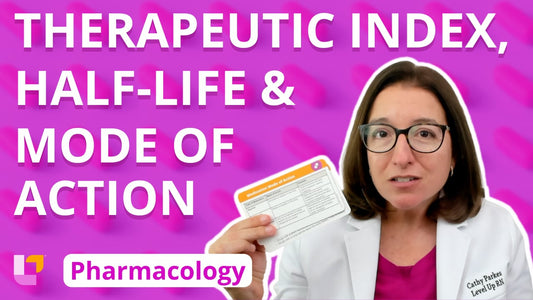
Pharmacology, part 6: Therapeutic Index, Half-Life, Mode of Action
Learn all about the therapeutic index, half-life, and mode of action of medications.
Pharmacology, part 6: Therapeutic Index, Half-Life, Mode of Action
Learn all about the therapeutic index, half-life, and mode of action of medications.
Nutrition Essentials
View all-
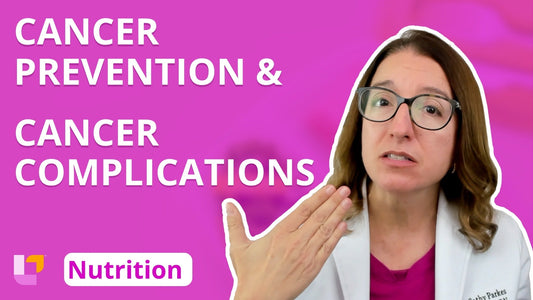
Nutrition, part 37: Nutrition for Cancer Prevention and Cancer Complications
Nutritional and lifestyle recommendations for cancer prevention. Key complications of cancer and cancer treatment, including decreased appetite and weight loss, xerostomia, taste alterations, and stomatitis.
Nutrition, part 37: Nutrition for Cancer Prevention and Cancer Complications
Nutritional and lifestyle recommendations for cancer prevention. Key complications of cancer and cancer treatment, including decreased appetite and weight loss, xerostomia, taste alterations, and stomatitis.
-
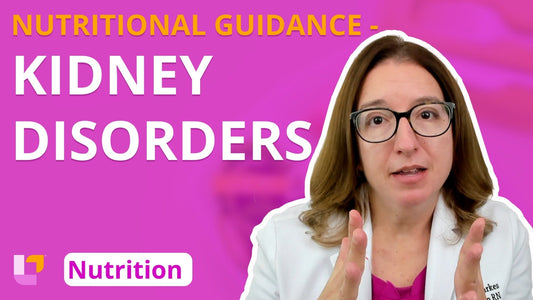
Nutrition, part 36: Nutritional Guidance for Kidney Disorders
Nutritional guidance for the following renal disorders: acute kidney injury (AKI), chronic kidney disease (CKD), nephrotic syndrome, glomerulonephritis, and urolithiasis (including nephrolithiasis).
Nutrition, part 36: Nutritional Guidance for Kidney Disorders
Nutritional guidance for the following renal disorders: acute kidney injury (AKI), chronic kidney disease (CKD), nephrotic syndrome, glomerulonephritis, and urolithiasis (including nephrolithiasis).
-
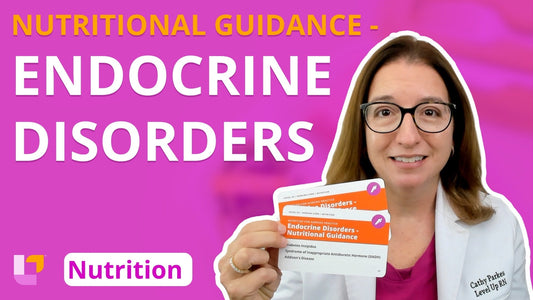
Nutrition, part 35: Nutritional Guidance for Endocrine Disorders
Nutritional guidance for the following endocrine disorders: diabetes insipidus (DI), syndrome of inappropriate antidiuretic hormone (SIADH), Addison's disease, Cushing's Syndrome, hypothyroidism, and hyperthyroidism.
Nutrition, part 35: Nutritional Guidance for Endocrine Disorders
Nutritional guidance for the following endocrine disorders: diabetes insipidus (DI), syndrome of inappropriate antidiuretic hormone (SIADH), Addison's disease, Cushing's Syndrome, hypothyroidism, and hyperthyroidism.
-
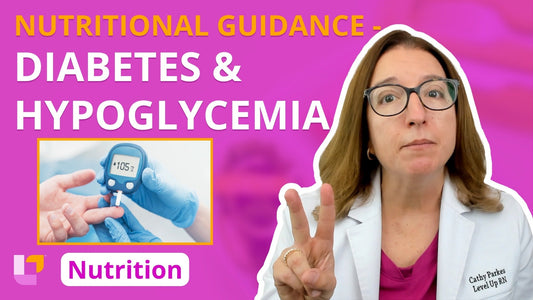
Nutrition, part 34: Nutritional Guidance for Diabetes & Hypoglycemia
Diabetes, including the signs/symptoms, nutritional guidance, and Somogyi phenomenon. Hypoglycemia, including the causes, signs/symptoms, and nutritional guidance for a conscious patient with hypoglycemia.
Nutrition, part 34: Nutritional Guidance for Diabetes & Hypoglycemia
Diabetes, including the signs/symptoms, nutritional guidance, and Somogyi phenomenon. Hypoglycemia, including the causes, signs/symptoms, and nutritional guidance for a conscious patient with hypoglycemia.
Pediatric Nursing
View all-

Pediatrics, part 91: Integumentary Disorders - Nursing Care of Burns
The nursing care of a pediatric patient with a burn injury. How to assess for the depth of the burn injury (i.e., superficial, superficial partial-thickness, deep partial-thickness, full-thickness, and deep...
Pediatrics, part 91: Integumentary Disorders - Nursing Care of Burns
The nursing care of a pediatric patient with a burn injury. How to assess for the depth of the burn injury (i.e., superficial, superficial partial-thickness, deep partial-thickness, full-thickness, and deep...
-

Pediatrics, part 90: Integumentary Disorders - Lyme Disease
Lyme disease. The pathophysiology, signs and symptoms for each stage of lyme disease, diagnosis of lyme disease, treatment of lyme disease, and prevention of lyme disease.
Pediatrics, part 90: Integumentary Disorders - Lyme Disease
Lyme disease. The pathophysiology, signs and symptoms for each stage of lyme disease, diagnosis of lyme disease, treatment of lyme disease, and prevention of lyme disease.
-

Pediatrics, part 89: Integumentary Disorders - Scabies & Lice
Scabies and lice. What scabies is, the signs and symptoms of scabies, and how scabies is treated. What pediculosis capitis is, how it is spread, signs and symptoms of a...
Pediatrics, part 89: Integumentary Disorders - Scabies & Lice
Scabies and lice. What scabies is, the signs and symptoms of scabies, and how scabies is treated. What pediculosis capitis is, how it is spread, signs and symptoms of a...
-
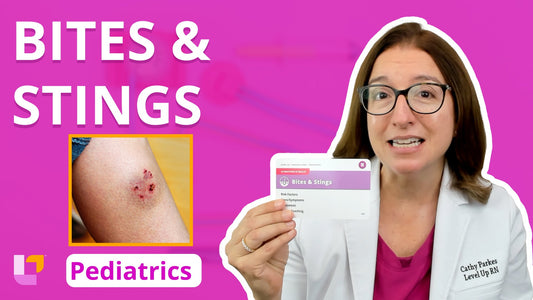
Pediatrics, part 88: Integumentary Disorders - Bites & Stings
Insect bites and stings, as well as animal bites. The signs/symptoms and treatment of uncomplicated insect bites/stings, as well as the signs/symptoms and treatment of anaphylaxis. The signs/symptoms of an...
Pediatrics, part 88: Integumentary Disorders - Bites & Stings
Insect bites and stings, as well as animal bites. The signs/symptoms and treatment of uncomplicated insect bites/stings, as well as the signs/symptoms and treatment of anaphylaxis. The signs/symptoms of an...
Arterial Blood Gas (ABG) Interpretation
View all-

ABG Interpretation, part 10: Example problems 9-12
In this video, Cathy covers ABG interpretation practice problems 9-12. You can download the practice questions and answer key and follow along as she explains how to work through the...
4 commentsABG Interpretation, part 10: Example problems 9-12
In this video, Cathy covers ABG interpretation practice problems 9-12. You can download the practice questions and answer key and follow along as she explains how to work through the...
4 comments -

ABG Interpretation, part 9: Example problems 5-8
In this video, Cathy covers ABG interpretation practice problems 5-8. You can download the practice questions and answer key and follow along as she explains how to work through the...
1 commentABG Interpretation, part 9: Example problems 5-8
In this video, Cathy covers ABG interpretation practice problems 5-8. You can download the practice questions and answer key and follow along as she explains how to work through the...
1 comment -

ABG Interpretation, part 8: Example problems 1-4
In this video, Cathy covers ABG interpretation practice problems 1-3. You can download the practice questions and answer key and follow along as she explains how to work through the...
4 commentsABG Interpretation, part 8: Example problems 1-4
In this video, Cathy covers ABG interpretation practice problems 1-3. You can download the practice questions and answer key and follow along as she explains how to work through the...
4 comments -

ABG Interpretation, part 7: Metabolic Alkalosis
ABG results for: Uncompensated Metabolic Alkalosis, Partially compensated Metabolic Alkalosis, and Fully compensated Metabolic Alkalosis. Plus, learn the causes, symptoms, and treatment of Metabolic Alkalosis.
ABG Interpretation, part 7: Metabolic Alkalosis
ABG results for: Uncompensated Metabolic Alkalosis, Partially compensated Metabolic Alkalosis, and Fully compensated Metabolic Alkalosis. Plus, learn the causes, symptoms, and treatment of Metabolic Alkalosis.
Psychiatric Mental Health Nursing
View all-
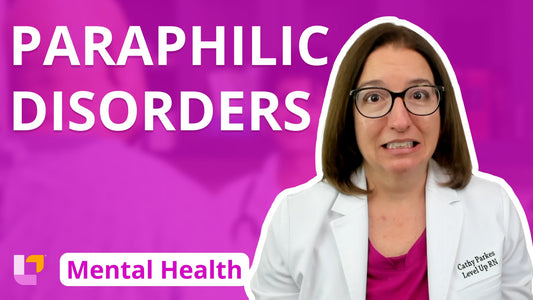
Psychiatric Mental Health, part 40: Disorders - Paraphilic Disorders
The difference between paraphilia and paraphilic disorders. Some of the main paraphilic disorders, including: exhibitionism, voyeurism, fetishism, frotteurism, sexual sadism, sexual masochism, and pedophilia.
Psychiatric Mental Health, part 40: Disorders - Paraphilic Disorders
The difference between paraphilia and paraphilic disorders. Some of the main paraphilic disorders, including: exhibitionism, voyeurism, fetishism, frotteurism, sexual sadism, sexual masochism, and pedophilia.
-

Psychiatric Mental Health, part 39: Disorders - Substance Use Disorders
Addiction and substance use disorders. Important terminology regarding addiction, including: intoxication, tolerance, dependence, and withdrawal. Alcohol use disorder, including the signs and symptoms of intoxication, signs and symptoms of withdrawal,...
Psychiatric Mental Health, part 39: Disorders - Substance Use Disorders
Addiction and substance use disorders. Important terminology regarding addiction, including: intoxication, tolerance, dependence, and withdrawal. Alcohol use disorder, including the signs and symptoms of intoxication, signs and symptoms of withdrawal,...
-
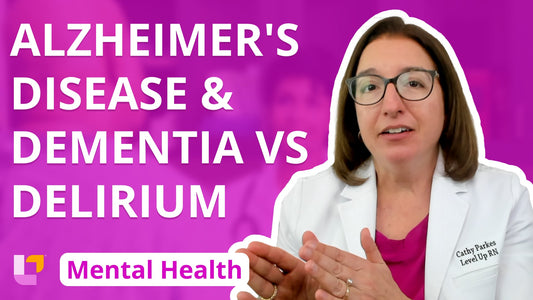
Psychiatric Mental Health, part 38: Disorders - Alzheimer's Disease & Dementia vs. Delirium
Alzheimer's disease and reviews the differences between dementia and delirium. The symptoms of early-stage, moderate-stage, and late-stage Alzheimer's disease, along with other symptoms associated with dementia, such as confabulation, preservation,...
Psychiatric Mental Health, part 38: Disorders - Alzheimer's Disease & Dementia vs. Delirium
Alzheimer's disease and reviews the differences between dementia and delirium. The symptoms of early-stage, moderate-stage, and late-stage Alzheimer's disease, along with other symptoms associated with dementia, such as confabulation, preservation,...
-

Psychiatric Mental Health, part 37: Disorders - Eating Disorders
Bulimia nervosa and anorexia nervosa: Signs, symptoms, hospitalization criteria, treatment, and nursing care. Binge eating disorder: common signs/symptoms, treatment, and nursing care.
Psychiatric Mental Health, part 37: Disorders - Eating Disorders
Bulimia nervosa and anorexia nervosa: Signs, symptoms, hospitalization criteria, treatment, and nursing care. Binge eating disorder: common signs/symptoms, treatment, and nursing care.
















































